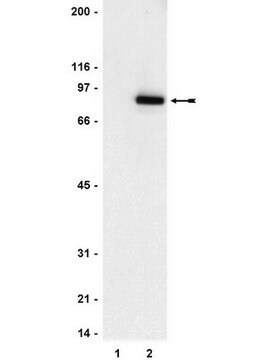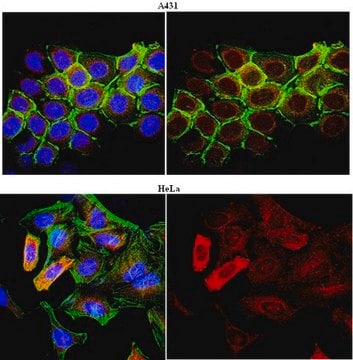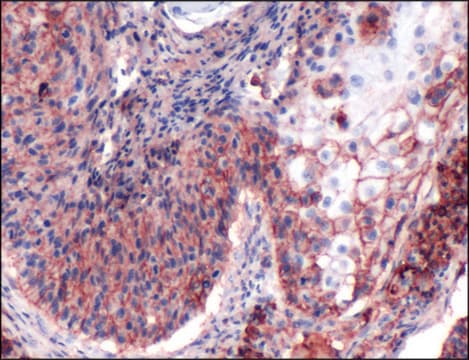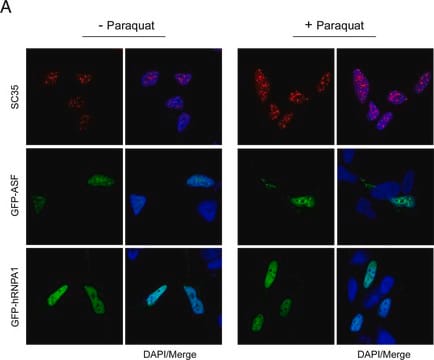06-596
Anti-STAT3 Antibody
Upstate®, from rabbit
Sinonimo/i:
Acute-phase response factor, DNA-binding protein APRF, signal transducer and activator of transcription, signal transducer and activator of transcription, (acute-phase response factor)
Scegli un formato
505,00 €
Spedizione prevista il11 aprile 2025Dettagli
Scegli un formato
About This Item
505,00 €
Spedizione prevista il11 aprile 2025Dettagli
Prodotti consigliati
Origine biologica
rabbit
Livello qualitativo
Forma dell’anticorpo
purified immunoglobulin
Tipo di anticorpo
primary antibodies
Clone
polyclonal
Reattività contro le specie
mouse, human, rat
Produttore/marchio commerciale
Upstate®
tecniche
ChIP: suitable
electrophoretic mobility shift assay: suitable
immunocytochemistry: suitable
immunoprecipitation (IP): suitable
western blot: suitable
Isotipo
IgG
N° accesso NCBI
N° accesso UniProt
Condizioni di spedizione
wet ice
modifica post-traduzionali bersaglio
unmodified
Informazioni sul gene
human ... STAT3(6774)
mouse ... Stat3(20848)
Descrizione generale
Specificità
Immunogeno
Applicazioni
4 μg of a previous lot immunoprecipitated STAT3 from 500 μg of EGF-stimulated A431 RIPA lysate.
Gel Shift Assay:
An independent laboratory has reported that this antibody supershifts.
Immunocytochemistry:
10 μg/mL of a previous lot of this antibody showed positive immunostaining for STAT3 in A431 cells fixed with 95% ethanol, 5% acetic acid.
Epigenetics & Nuclear Function
Transcription Factors
Qualità
Western Blot Analysis:
0.5-2 μg/mL of this lot detected STAT3 in RIPA lysates from EGF stimulated human A431 cells and previously from mouse WEHI and rat L6.
Descrizione del bersaglio
Linkage
Stato fisico
Stoccaggio e stabilità
Handling Recommendations: Upon first thaw, and prior to removing the cap, centrifuge the vial and gently mix the solution. Aliquot into microcentrifuge tubes and store at -20°C. Avoid repeated freeze/thaw cycles, which may damage IgG and affect product performance.
Risultati analitici
Positive Antigen Control: Catalog #12-302, EGF-stimulated A431 cell lysate. Add 2.5µL of 2-mercaptoethanol/100µL of lysate and boil for 5 minutes to reduce the preparation. Load 20µg of reduced lysate per lane for minigels.
Altre note
Note legali
Esclusione di responsabilità
Non trovi il prodotto giusto?
Prova il nostro Motore di ricerca dei prodotti.
Raccomandato
Codice della classe di stoccaggio
12 - Non Combustible Liquids
Classe di pericolosità dell'acqua (WGK)
WGK 1
Punto d’infiammabilità (°F)
Not applicable
Punto d’infiammabilità (°C)
Not applicable
Certificati d'analisi (COA)
Cerca il Certificati d'analisi (COA) digitando il numero di lotto/batch corrispondente. I numeri di lotto o di batch sono stampati sull'etichetta dei prodotti dopo la parola ‘Lotto’ o ‘Batch’.
Possiedi già questo prodotto?
I documenti relativi ai prodotti acquistati recentemente sono disponibili nell’Archivio dei documenti.
Filtri attivi
Il team dei nostri ricercatori vanta grande esperienza in tutte le aree della ricerca quali Life Science, scienza dei materiali, sintesi chimica, cromatografia, discipline analitiche, ecc..
Contatta l'Assistenza Tecnica.








